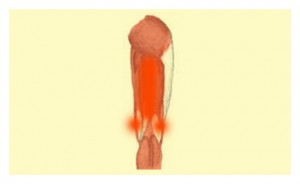Hamstring Tendon Injury Symptoms
The symptoms of tendinitis often get progressively worse when not given proper rest or treatment. You may initially feel pain and tenderness in the hip or knee area, but continue with activities thinking it will go away. Unfortunately, the pain and inflammation will continue until the tendon is allowed to rest and the damaged tissue is treated properly. If tendinitis symptoms are ignored it can become a chronic condition where the tendon tissue begins to deteriorate and weaken (tendinosis).
The symptoms of hamstring tendonitis include:
Hip and/or Knee Stiffness
Decreased mobility and stiffness in your hip or knee during and after exercise can be experienced, especially at night. If allowed to progress, you may start to experience stiffness at rest.
Pain and Tenderness
Pain and tenderness in and around your knee (small area along the back and sides of your knee to the top of your shin bone) or around your ischial tuberosity (the bony part of your butt and the back of your upper thigh).
Depending on your location of pain, you may experience discomfort in your knee and hip when you bend your knee or squat against resistance, or when you straighten your leg and extend your hip, because your tendon is forced to stretch.
This pain often develops slowly and becomes more painful when overexerting yourself or after exercise. You can also experience pain with prolonged sitting.
Stages of tendinitis pain:
- Minor twinges that occur early in your workouts and generally go away after warming up; we often ignore these, however they tend to indicate the first signs of tendinitis (normally a few weeks to 3 months)
- Pain that stays longer and returns after workout (normally 3 -6 months)
- Pain that is constant (normally have it for 6+ months)
Weakness
Loss of strength in your hamstring muscles and tendons which makes it difficult for you to walk or run and can result in you walking with a limp.
Swelling
Swelling where your hamstring tendon inserts on your knee/shinbones (around the back edges of the knee) or near your upper thigh and “sit bones” can occur. However, if you have tendinosis, you may not experience any swelling. You may also notice some redness and warmth around the area of your tendon attachment, which can often indicate another injury to your joint capsule.
With hamstring tendinopathy (chronic tendon injury) you may also experience lumbar lordosis and an anterior pelvic tilt.
Hamstring Pain Diagnosis
Your doctor will take your medical history and will examine your hamstring for any inflammation and deformities. He/she will analyze your flexibility, stability, and gait (the way you walk). Occasionally an x-ray (check for bone and joint inflammation or arthritis), or MRI scans or CT scans (to show soft tissue damage) may be requested.
Hamstring Tendon Treatments
Regardless of the cause of your hamstring injury. You want the pain to stop and to be able to use your hamstring again as soon as possible. It is important to treat hamstring tendon injuries as soon as possible, as any activity or strain you put on your tendon can re-injure it further. Though the pain, discomfort, and inconvenience of a hamstring injury can be overwhelming, it is possible to overcome it.
As your body repairs your tendon it is best that it heal to quickly so there is minimal scar tissue formation – something Blood Flow Stimulation Therapy™ is great at! Even with optimum healing, there is always less elasticity in a previously injured tendon. This can cause the tendon to hurt during exercise and most everyday activities. However, if you heal your injured tendon efficiently and quickly, yourchance of re-injury later on is much lower.
Although it is recommended that you rest your hamstring tendons following injury it can be difficult to do as it is an essential tendon for walking and daily activities. Fortunately, there are healing tools that can help treat your tendon and speed up the healing process so you can get back to a life without pain and risk of further injury.

